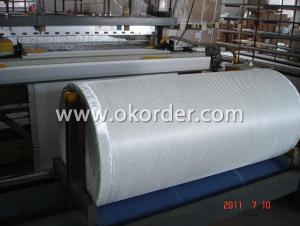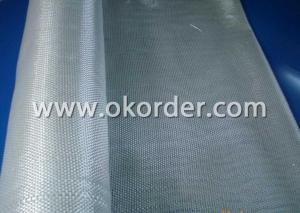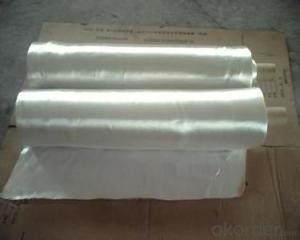Silica88 Silica Fiber Cloth - Fiberglass Fabrics
- Loading Port:
- China Main Port
- Payment Terms:
- TT OR LC
- Min Order Qty:
- -
- Supply Capability:
- -
OKorder Service Pledge
Quality Product, Order Online Tracking, Timely Delivery
OKorder Financial Service
Credit Rating, Credit Services, Credit Purchasing
You Might Also Like
Quick Details
| Place of Origin: | Brand Name: | Model Number: | |||
| Application: | Weight: | Width: | |||
| Weave Type: | Yarn Type: | Alkali Content: | |||
| Standing Temperature: | Certificate: | Color: | |||
| Thickness: | Roll Length: | Weave: | |||
| Port of Loading: | Warp yarn: | Fill yarn: | |||
| Warp/Weft density: | Instant working temp: |
Packaging & Delivery
| Packaging Detail: | as customer request |
| Delivery Detail: | in 15 to 30 days |
Specifications
1. Silica88 silica fiber cloth
2. High temperature resistance
3. Refractory
- Q: How does fiberglass fabric perform in fire-resistant applications?
- Due to its inherent properties, fiberglass fabric is an exceptional option for fire-resistant applications. Unlike other materials, fiberglass fabric does not burn or support combustion when exposed to fire. It maintains its structural integrity even at high temperatures due to its high melting point. Moreover, when fiberglass fabric is exposed to fire, it does not release toxic gases or smoke. This characteristic makes it a safe choice for fire-resistant applications, especially in enclosed spaces. The absence of toxic fumes helps prevent health risks and ensures a secure evacuation. Additionally, fiberglass fabric offers various advantages beyond its fire resistance. It is lightweight and flexible, making it easy to handle and install. Furthermore, it is highly durable and resistant to chemicals, moisture, and UV radiation. In conclusion, fiberglass fabric proves to be an excellent option for fire-resistant applications. Its ability to withstand high temperatures, non-combustible nature, and resistance to toxic fumes make it a reliable and safe solution. Industries such as construction, automotive, aerospace, and manufacturing can greatly benefit from its fire protection capabilities.
- Q: How do fiberglass fabrics perform in terms of moisture wicking?
- Fiberglass fabrics lack the typical ability to wick away moisture. Unlike fabrics made from natural fibers like cotton or wool, fiberglass fabrics do not possess inherent moisture-wicking capabilities. This is mainly because fiberglass is non-absorbent, making it difficult for moisture to be absorbed and carried away from the skin. However, it is worth noting that fiberglass fabrics can still be utilized in certain applications where moisture management is not the main concern. Fiberglass is commonly chosen for its exceptional mechanical properties, including high strength, durability, and resistance to heat, chemicals, and fire. Therefore, in industries such as automotive, aerospace, and construction, fiberglass fabrics are selected based on these advantageous characteristics rather than their ability to wick away moisture. In situations where moisture management is vital, other fabric options that possess moisture-wicking capabilities are generally preferred. Fabrics like polyester, nylon, or blends with natural fibers like cotton or bamboo are known for their ability to absorb moisture and transport it away from the body, ensuring the wearer stays dry and comfortable. To conclude, although fiberglass fabrics may not provide significant moisture-wicking properties, they are still widely used in various industries due to their numerous other advantageous characteristics.
- Q: What are the differences between Geogrid, glass fiber network and geotextile?
- A grille is made of polypropylene, PVC polymer and thermoplastic or molded by two-dimensional grid or a certain height of the three-dimensional mesh screen, when used as a civil engineering, called geogrid. Engineering applications: highway, railway, abutment, approach road, wharf, dam, slag yard and other soft soil foundation reinforcement, retaining wall and pavement anti cracking projects, and other fields.
- Q: What are the typical applications of fiberglass fabrics?
- Fiberglass fabrics have a wide range of applications due to their unique properties and versatility. Some of the typical applications of fiberglass fabrics include: 1. Construction: Fiberglass fabrics are widely used in the construction industry for reinforcing concrete structures. They are used as a substitute for steel reinforcement in applications such as walls, beams, and columns. Fiberglass fabrics provide high strength, corrosion resistance, and durability, making them suitable for various construction projects. 2. Automotive industry: Fiberglass fabrics find application in the automotive industry for manufacturing lightweight and high-performance parts. They are used to reinforce body panels, interior components, and structural parts. Fiberglass fabrics offer excellent strength-to-weight ratio and impact resistance, making them ideal for improving fuel efficiency and reducing vehicle weight. 3. Aerospace and aviation: Fiberglass fabrics are used in the aerospace and aviation industry for manufacturing aircraft components. They are used in the construction of aircraft wings, fuselage panels, interior structures, and fairings. Fiberglass fabrics provide high strength, stiffness, and resistance to extreme temperatures, making them suitable for demanding aerospace applications. 4. Marine industry: Fiberglass fabrics are extensively used in the marine industry for boat and yacht construction. They are used to build hulls, decks, bulkheads, and other structural components. Fiberglass fabrics offer excellent resistance to water, chemicals, and UV radiation, making them ideal for marine applications. 5. Sports and recreation: Fiberglass fabrics are commonly used in the sports and recreation industry for manufacturing various equipment and products. They are used to create sporting goods like golf clubs, fishing rods, archery bows, and surfboards. Fiberglass fabrics provide high strength, flexibility, and impact resistance, making them suitable for demanding sports applications. 6. Electrical insulation: Fiberglass fabrics find application in electrical insulation due to their non-conductive properties. They are used as insulating materials in electrical components like circuit boards, transformers, and electrical motors. Fiberglass fabrics offer excellent thermal stability, electrical insulation, and flame retardancy, making them ideal for electrical applications. Overall, fiberglass fabrics are widely used in various industries due to their exceptional properties such as high strength, durability, corrosion resistance, lightweight, and flexibility. These fabrics provide excellent solutions for diverse applications ranging from construction and automotive to aerospace and sports.
- Q: Is fiberglass fabric resistant to chemicals in oil and gas industry?
- Yes, fiberglass fabric is resistant to chemicals in the oil and gas industry. Fiberglass is known for its excellent chemical resistance properties, making it suitable for various industrial applications, including the oil and gas industry. It is resistant to a wide range of chemicals, including acids, alkalis, solvents, and hydrocarbons, which are commonly found in the oil and gas industry. Additionally, fiberglass fabric is also resistant to high temperatures, fire, and UV radiation, making it a durable and reliable material choice for use in this industry.
- Q: How much glass fiber cloth and how much epoxy resin does it take to make a square meter of fiberglass?
- About 500 grams to about 800 grams.
- Q: Can fiberglass fabric be used for reinforcement in boat hulls?
- Yes, fiberglass fabric can indeed be used for reinforcement in boat hulls. Fiberglass is a popular choice for boat construction due to its high strength-to-weight ratio, durability, and resistance to water and corrosion. When used as a reinforcement material, fiberglass fabric is typically laid up in multiple layers and impregnated with a resin, such as polyester or epoxy, to form a composite structure. This composite material provides increased stiffness and strength to the hull, making it more resistant to impacts and flexing. Additionally, fiberglass fabric can be easily molded into complex shapes, making it suitable for reinforcing various parts of a boat hull. Overall, fiberglass fabric is a versatile and reliable option for reinforcing boat hulls and is widely used in the marine industry.
- Q: Can fiberglass fabric be used for insulation in renewable energy projects?
- Insulation in renewable energy projects can utilize fiberglass fabric. This fabric is commonly used for thermal insulation in a variety of applications, including renewable energy projects. Its excellent insulating properties and high thermal resistance make it suitable for insulating components like pipes, ducts, and equipment in solar, wind, geothermal, and other renewable energy systems. Fiberglass fabric is famous for its ability to prevent heat transfer effectively due to its low thermal conductivity. This is crucial in renewable energy projects where minimizing heat loss or gain is vital for optimal system performance and energy efficiency. By employing fiberglass fabric insulation, the energy generated from renewable sources can be efficiently utilized without being wasted due to inefficient insulation. Moreover, fiberglass fabric is lightweight, flexible, and easy to handle, making it appropriate for various installation requirements. It can be easily cut, shaped, and wrapped around different components, ensuring a proper fit and efficient insulation coverage. In addition to its exceptional thermal properties, fiberglass fabric insulation also offers other advantages. It is non-combustible, meaning it does not burn or contribute to the spread of fire. This is particularly important in renewable energy projects where safety is of utmost importance. Additionally, fiberglass fabric is resistant to moisture, chemicals, and UV radiation, guaranteeing long-lasting insulation performance even in harsh environmental conditions. All in all, fiberglass fabric is a versatile and dependable choice for insulation in renewable energy projects. Its thermal resistance, ease of installation, and durability make it an ideal solution to maximize energy efficiency and ensure the smooth operation of renewable energy systems.
- Q: Are fiberglass fabrics suitable for use in the automotive industry?
- Yes, fiberglass fabrics are suitable for use in the automotive industry. They are lightweight, strong, and durable, making them ideal for various applications such as reinforcing body panels, manufacturing interior trim components, and creating structural supports. Fiberglass fabrics also offer resistance to heat, chemicals, and corrosion, making them a reliable choice for automotive applications.
- Q: How does fiberglass fabric perform in chemical exposure?
- The performance of fiberglass fabric in chemical exposure is exceptional. It is widely used in various industries where exposure to corrosive substances is expected, thanks to its inherent resistance to a wide range of chemicals. The fabric is composed of woven glass fibers, which create a strong barrier against chemical attack and degradation. Fiberglass fabric can withstand exposure to acids, alkalis, solvents, and other corrosive chemicals without significant damage or deterioration in many cases. This resistance to chemical attack makes it an excellent choice for chemical storage tanks, pipes, ducts, and equipment linings. Furthermore, the fabric's non-reactive nature prevents contamination or leaching of chemicals into the surrounding environment, making it a safe and reliable option for handling hazardous substances. Additionally, its thermal insulation properties enhance its performance in chemical exposure by providing protection against extreme temperatures that may accompany certain chemical processes. However, it is important to consider that the specific performance of fiberglass fabric in chemical exposure may vary depending on factors such as the type and concentration of the chemical, as well as the duration and temperature of exposure. Therefore, it is always advisable to consult manufacturers or industry experts to ensure the suitability of fiberglass fabric for a specific application and to determine any necessary precautions or compatibility considerations.
Send your message to us
Silica88 Silica Fiber Cloth - Fiberglass Fabrics
- Loading Port:
- China Main Port
- Payment Terms:
- TT OR LC
- Min Order Qty:
- -
- Supply Capability:
- -
OKorder Service Pledge
Quality Product, Order Online Tracking, Timely Delivery
OKorder Financial Service
Credit Rating, Credit Services, Credit Purchasing
Similar products
Hot products
Hot Searches
Related keywords
























